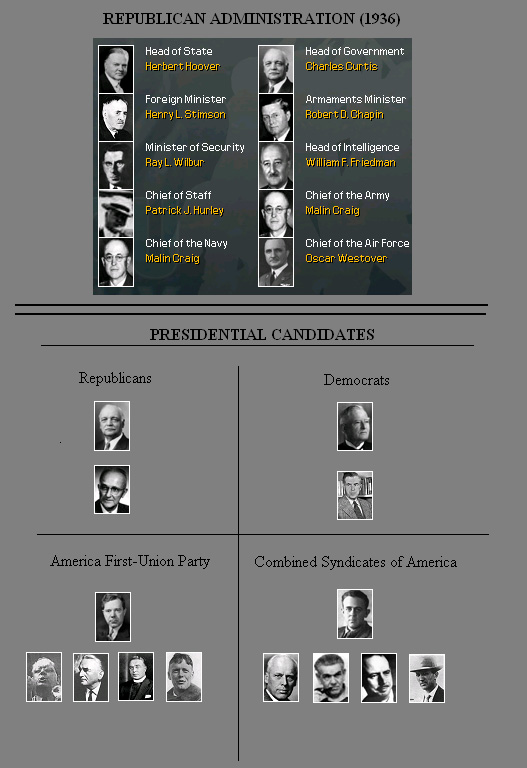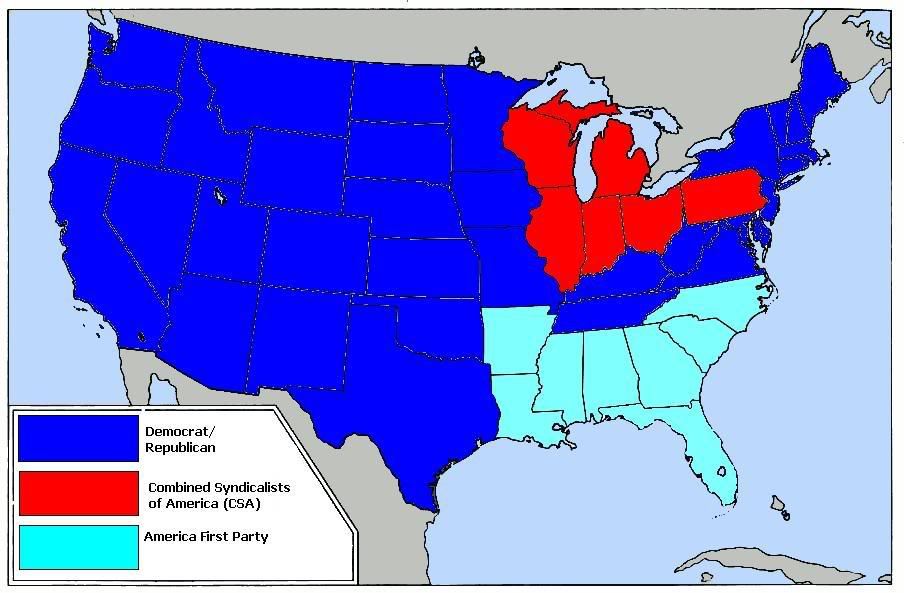United States
From Kaiserreich
(Added Foreign relations (simplified)) |
m (minor edit + puppets in foreign relations) |
||
| Line 38: | Line 38: | ||
|} | |} | ||
| - | + | The '''United States of America''' is a country in North-America. It is bordered by [[Canada]] in the north and [[Mexico]] in the south. | |
| - | The United States of America is a country in North-America. It | + | |
==History== | ==History== | ||
| Line 96: | Line 95: | ||
== Foreign relations == | == Foreign relations == | ||
| - | Friendly relations with [[Cuba]], [[Honduras]], [[Panama]], [[Philippines]] and [[United Provinces]]. | + | The United States of America have political, economic and military control over [[Liberia]] and [[Philippines]]. |
| + | |||
| + | Friendly relations with [[Cuba]], [[Honduras]], [[Panama]], [[Liberia]], [[Philippines]] and [[United Provinces]]. | ||
Unfriendly relations with [[Mexico]], [[Centroamerica]] and [[Germany]]. | Unfriendly relations with [[Mexico]], [[Centroamerica]] and [[Germany]]. | ||
Revision as of 14:54, 30 July 2010
| ||||
| Motto In God We Trust (official) E Pluribus Unum (From Many, One - Traditional) | ||||
| Anthem The Star-Spangled Banner | ||||
| National Language | English | |||
| Capital | Washington D.C. | |||
| President of the United States | Herbert Clark Hoover | |||
| Establishment - Declaration of Independance | July 4, 1776 | |||
| Government | Constitutional federal presidential republic | |||
| Currency | United States Dollar | |||
| Area | 9,826,630 km² | |||
| Population | More than 128 million | |||
The United States of America is a country in North-America. It is bordered by Canada in the north and Mexico in the south.
Contents |
History
While the United States economy grew tremendously during the Weltkrieg, with American banks and factories supplying the Entente war effort, the 1920s were disastrous. The military and political collapse of France and Britain meant that any American investments or loans to these two countries were irrecoverably lost. German dominance over world trade ensured that America was progressively forced out of markets in Europe, Africa, Asia and even parts of South America. A slow but inexorable economic decline ensued, followed by an increasingly vicious social conflict.
Up until now, the two party system has been held in place, with both Democrats and Republicans maintaining the support of American industry and big business, and with any extremist groups being fragmented and disunited. However, the inefficient second term of President Hoover’s Presidency has seen a significant shift in the political constellation of America. Two grand coalitions have formed, one uniting the forces of the populist and technocratic right, and the other the revolutionary left, and are both mobilizing to fight for their own man to become the 32nd President of the United States in 1936.
Politics
President of the United States: Herbert Clark Hoover (Republican, born 10 August 1874)
Vice President of the United States: Charles Curtis (Republican, born 25 January 1860)
Secretary of State: Henry Lewis Stimson (Republican, born 21 September 1867)
Secretary of Commerce: Roy Dikeman Chapin (Republican, born 23 February 1880)
Secretary of the Interior: Ray Lyman Wilbur (Republican, born 13 April 1875)
Head of Signals Intelligence Service: William Frederick Friedman (born 24 September 1891)
Secretary of War: Patrick Jay Hurley (Republican, born 8 January 1883)
Chief of Staff of the United States Army: Major General Douglas MacArthur (born 26 January 1880)
Chief of Naval Operations: Rear Admiral Robert Lee Ghormley (born 15 October 1883)
Chief of the United States Army Air Corps: Major General Edward Vernon Rickenbacker (born 8 October 1890)
During the Presidential Elections of 1936, Herbert Hoover is to step down, and his Vice President, Charles Curtis is to run for the Presidency as the Republican Candidate, with Frank Knox as his running mate. John Nance Garner, supported by Henry A. Wallace, is the candidate for the Democrats.
The America First Union Party has selected Huey Long, Senator for Louisiana, as its candidate. With its support primarily coming from the depressed agricultural regions of the South and Mid-West, the new party combines traditional populism with neo-capitalist modes of organisation, demanding redistribution of wealth and social welfare, but within a strong centralised corporatist economic structure, controlled by a paternalistic economic and political elite.
The Combined Syndicates of America are led by John 'Jack' Reed, who was turned into a savvy political operator during his time in Russia during its revolution and civil war. Uniting various shades of socialist, syndicalist and communist opinion, the CSA have mobilised the surging throngs of workers in America's industrial heartlands.
The predicted breakdown of support by electoral college district is as follows:
|
All sides are currently organising for the elections, and are restraining their supporters from resorting to violence. But, should the result not move in their favour, the two radical parties have both built formidable voluntarist and paramilitary organisations, which could quickly replace the authority of the Federal Government in their areas of dominance. Likewise, unlike the rest of the country, California and the Western States have prospered, largely thanks to maritime trade with Russia and Japan, and so are thought to be unwilling to submit to any overly radical programme.
Military
The United States armed forces comprises of four service branches: The Army, the Navy, the Marine Corps and the Coast Guard. The Army Air Corps is a department of the Army. In general, the US armed forces have huge potential. The United States is one of the foremost industrial nations in the world and has a large population and innovative thinkers. However, the armed forces are currently very divided by the political tensions of the US.
Army
The US Army is the largest service branch by the number of men employed. Currently it has four divisions, three infantry divisions and one cavalry division. The US Army is not very big or powerful compared to the German Heer, for example, but it has huge manpower reserves and the industrial capacity of the nation means that the Army would be well armed and supplied even if it had 200 divisions.
Navy
The US Navy is the most modern and powerful branch of the armed forces. It's one of the few navies in the world that operate aircraft carriers and it has a significant amount of battleships in service. The Navy maintains a presence in two oceans, the Pacific and the Atlantic. The Pacific Fleet is the stronger of the two fleets.
Army Air Corps
Foreign relations
The United States of America have political, economic and military control over Liberia and Philippines.
Friendly relations with Cuba, Honduras, Panama, Liberia, Philippines and United Provinces.
Unfriendly relations with Mexico, Centroamerica and Germany.
Culture
WIP




